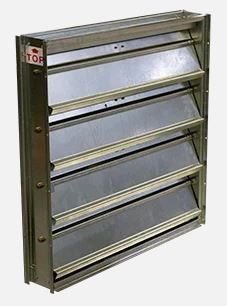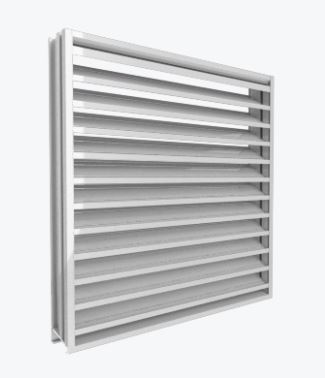Most modern industrial ventilation systems engineered by Eldridge feature two essential components: louvers and backdraft dampers. While both components regulate airflow, they serve distinct functions. In this comprehensive guide to louvers and backdraft dampers, we’ll explore their similarities, differences, and specific purposes, along with the key factors that determine their selection for various applications.
Similarities and Differences
When examining a building’s ventilation system, it’s easy to mistake louvers for backdraft dampers. Viewed from the exterior, they share visual similarities, featuring an outer frame and horizontal blade configuration. Additionally, both components are typically installed on building walls and function as either intake or exhaust points in ventilation systems. However, these commonalities are where the resemblance ends. The fundamental physical distinction lies in their blade design – backdraft dampers feature movable blades, while louver blades are typically stationary. Their purposes also differ significantly. In ventilation systems, louvers primarily function as filtration devices, blocking unwanted elements like sand, precipitation, and snow, whereas backdraft dampers are designed to control airflow direction.
Backdraft Dampers
 In ventilation applications, backdraft dampers are often called shutters. These devices utilize blade weight to control airflow direction. A common implementation is their placement at fan outlets. During fan operation, airflow forces the damper blades open, allowing air movement in the intended direction. When the fan stops, the blades’ weight naturally returns them to their closed position, preventing reverse airflow through the fan opening.
In ventilation applications, backdraft dampers are often called shutters. These devices utilize blade weight to control airflow direction. A common implementation is their placement at fan outlets. During fan operation, airflow forces the damper blades open, allowing air movement in the intended direction. When the fan stops, the blades’ weight naturally returns them to their closed position, preventing reverse airflow through the fan opening.
Backdraft dampers can also be equipped with counterweights for specific pressure activation. This feature is particularly valuable in ventilation systems utilizing truck or personnel doors as primary air pathways. If these access points become partially or fully closed, the calibrated backdraft damper activates at predetermined pressure levels, maintaining proper airflow and preventing potentially dangerous pressure buildup inside the facility.
Louvers
 Louvers typically feature fixed-position blades engineered to filter unwanted elements from airflow. Three critical factors determine louver selection for specific applications: penetration velocity, free area, and pressure drop. Penetration velocity defines the maximum air speed through the louver required to effectively block unwanted elements. Since water exclusion represents the most common louver application, manufacturers provide detailed specifications showing water penetration rates relative to air velocity through the louver.
Louvers typically feature fixed-position blades engineered to filter unwanted elements from airflow. Three critical factors determine louver selection for specific applications: penetration velocity, free area, and pressure drop. Penetration velocity defines the maximum air speed through the louver required to effectively block unwanted elements. Since water exclusion represents the most common louver application, manufacturers provide detailed specifications showing water penetration rates relative to air velocity through the louver.
The louver’s free area plays a crucial role in determining appropriate sizing requirements. For instance, consider an application involving an exhaust fan that is moving 15,000 CFM. For effective water exclusion at the air inlet, we’ve incorporated a drainable blade louver featuring a 55% free area. Based on the established water penetration velocity limit of 1,000 feet per minute, our calculations indicate a required louver size of 27.3 square feet, or specifically, 62.7″ by 62.7″ at the air inlet (calculated as: 15,000 CFM ÷ 1,000 ft/min ÷ .55 = 27.3 square feet).
The pressure differential created by a louver directly correlates with the velocity of air passing through it. When determining fan specifications, engineers must account for this louver-induced pressure drop alongside pressure reductions caused by other ventilation system components to ensure optimal airflow delivery.
Conclusion
We at Eldridge trust this comprehensive guide to louvers and backdraft dampers has provided valuable insights into the distinct characteristics and applications of louvers and dampers, enabling you to make informed decisions when selecting the appropriate component for your specific ventilation requirements.
